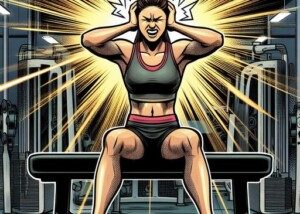As you get older over many years, have you noticed that other people in the gym stay in their 20s and 30s?
Where have all your peers gone?
As the years pass and societal landscapes evolve, one intriguing phenomenon within the fitness realm remains conspicuous: the preponderance of gym-goers in their 20s and 30s.
This is particularly obvious in the free weight areas, and then second with weight machines.
When I had my first gym membership at age 21, most people there were in their 20s, then 30s, and some teens.
In my 30s, it was the same thing.
In my 40s — again, same thing: Most users were in their 20s, then 30s, and some teenagers.
So when I was in my 40s, I’d wonder where were all the people who, when I was in my 20s, had also been in their 20s?
As I get older (I’m 50+), the average age of men and women doing strength training, especially with free weights, remains constant! It stays primarily in the 20s.
Where oh where are all the 50-somethings who were in their 20s and 30s when I was working out in my 20s and 30s?
In fact, this is highly apparent the more crowded the gym is — and I mean ANY gym.
I’ve belonged to chain gyms for decades, and also visited gyms in other states when traveling, and lived in several states as well.
The dropout is a universal phenomenon.
If all the people whom I had observed lifting, when I was in my 20s, were still hitting the gym — then any gym I go to should be packed with people in their 50s and 60s.
But as I’ve gotten older, people my age just keep dropping out more and more.
There are times when, I swear, I’m the oldest in the gym — or at least, the oldest working out with barbells.
And needless to say, I’m by far the oldest doing deadlifts, dumbbell squats, tire squats, overhead presses and 50 pound kettlebell swings.
Why am I the only one “from my generation” who’s still sticking around, let alone continuing to kill it at the gym?
Let’s examine this peculiar phenomenon — the disappearing act of gym members once they hit 40.
Why the Mean Gym Member Age Is Always in the 20s As Years Go By
Here are some explanations, in no particular order.
Lifestyle Dynamics. Those in their 20s and 30s often find themselves in a phase of life characterized by increased flexibility, fewer familial obligations and a generally more liberated schedule.
This allows them the luxury of time to prioritize regular gym attendance.
As people age, the demands of careers, parenting and other responsibilities can intensify, making it challenging to carve out dedicated time for fitness activities.
However, you’d think that once the nest is empty and people are retired, they’d have that time back to return to the gym.
That’s not the case, though. Old people I see in the gym are obviously new at it, with occasional exceptions.
I’ve seen old men — age spots and all — with muscled physiques and impressive workouts.
Less frequently but certainly a thing, is the dedication of women 50+ with physiques any 30-year-old would kill for.
But there observations are so very uncommon.
Social Aspects of Exercise. Gyms are not merely spaces for physical exertion; they also serve as social hubs.
Younger members might be drawn to the communal aspects of group workouts.
The camaraderie and social interaction inherent in these settings can make the gym a more attractive option for those in their 20s and 30s.
As people age, their social circles may undergo changes, and the desire for solitude or alternative social activities might influence their choice of exercise venues.
Motivations and Priorities. In the 20s and 30s, individuals may be more driven by aesthetic considerations and the desire for physical prowess.
As people move into their 40s and beyond, health considerations and a focus on long-term well-being may take precedence.
The shifting priorities might lead men and women to explore alternative forms of exercise beyond the traditional gym setting.
Health and Wellness Awareness. The awareness of health and wellness often experiences a surge in one’s 20s and 30s.
This age group is more likely to be attuned to societal messages emphasizing the importance of staying active and maintaining a healthy lifestyle.
Injury Prevention and Adaptation. As people age, concerns about injury prevention and overall joint health may become more prominent.
Older people may opt for lower-impact activities or sports that are gentler on the joints.
This inclination to prioritize joint-friendly exercises can divert them from the intense and sometimes high-impact workouts commonly associated with gym settings.
Economic Considerations. The younger crowd, who may be at an earlier stage in their careers, could be more willing to allocate funds for gym memberships.
As people age and face additional financial responsibilities, the perceived value of gym memberships may decrease relative to other fitness options.
But this idea doesn’t quite ring true when you give it more thought.
That’s because many people over 40 and 50 and beyond are still making bank and/or receiving good pensions. Not to mention that the kids are grown and gone.
On the other hand, “I finally have the money for my dream home gym,” may be at play here as well.
The Final — and Perhaps the Most Likely Reason
Quite frankly, it’s because as people who seriously lift weights get older, many blow out their tendons.
Nobody really knows what the smoking gun here is with the disappearing act, but it just seems most logical that most of the dropout is caused by tendon injuries.
As it is, it’s not difficult to notice a younger adult at the gym with tendon or joint protection while strength training, such as elbow wraps and knee braces.
These would help alleviate stress on the inner and outer elbow tendons, quadriceps tendon and patellar tendon.
It’s not hard to find someone around 40 who’s doing obvious rotator cuff rehab movements.
I’ve had injuries to the following related to lifting weights: rotator cuff tendons, biceps tendon, medial epicondyle tendon and quadriceps tendon.
Tendons take forever to bounce back 100 percent. This requires tremendous patience with rehab exercises.
Many people, particularly men, have the mindset of just “working through the pain” or “toughing it out,” further damaging the tendon and preventing full recovery.
I’ve always fully recovered from all of my tendon issues, patiently working around them or even laying off anything more than light resistance, knowing that this would be the only way to achieve full recovery.
For instance, I once brought my deadlift down to a pathetic 60 pounds once I admitted that this was the only way to cure my elbow tendonitis.
It took forever to get it up to 135 pounds without elbow pain. But my patience persisted, and ultimately I was back to where I’d been pre-injury.
But this approach is unthinkable to many muscle building enthusiasts!
A lot of weightlifting enthusiasts are not willing to spend more than a week giving up the heavy or intense training.
They compensate with altered form (which can cause new injuries), wraps and painkillers — till finally, there’s too much chronic tendon damage to make regular gym workouts worthwhile. They stop coming.
Very likely, they continue with some form of strength training they can easily do at home.
And this would, from a logic standpoint, be the best explanation for why people at gyms are always in their 20s and 30s, particularly in the free weight area.










































